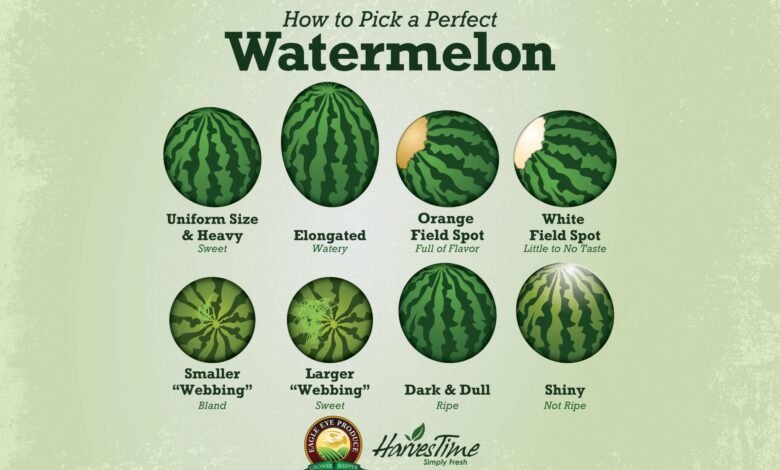How to Pick a Watermelon: A Comprehensive Guide

Selecting the perfect watermelon can transform a simple summer day into an unforgettable experience. This comprehensive guide will delve into the art and science of choosing a ripe, juicy watermelon, ensuring that your next picnic or barbecue is a hit. From understanding the basics of watermelon varieties to mastering the signs of peak ripeness, we’ll cover everything you need to know. So, let’s dive into the world of watermelons and turn you into a melon-picking maestro.
Understanding Watermelon Varieties
Before you can master the art of picking, it’s crucial to know what you’re looking for. Watermelons come in various shapes, sizes, and colors, each with unique characteristics. The most common types include seeded, seedless, mini, and yellow/orange fleshed watermelons. Seeded varieties are traditional, with black seeds scattered throughout the flesh. Seedless watermelons, developed for convenience, contain no mature seeds but may have small, white seed coats. Mini watermelons are compact, ideal for small households, while yellow and orange varieties offer a different taste experience with their unique flesh colors.
Where to Buy Your Watermelon
Your watermelon’s origin can significantly impact its taste and freshness. Local farmers’ markets are excellent sources of fresh, flavorful watermelons, often picked at peak ripeness. Grocery stores offer convenience and variety, but the watermelons may have been harvested earlier to withstand transportation. When possible, choose locally grown watermelons for the freshest taste.
Inspecting the Watermelon
The first step in picking a watermelon is visual inspection. Look for a firm, symmetrical watermelon free from bruises, cuts, or dents. The shape doesn’t necessarily affect the flavor, but irregularities can indicate uneven ripening or internal damage. The watermelon should be heavy for its size, a sign of high water content and ripeness.
The Field Spot: A Telltale Sign of Ripeness
One of the most reliable indicators of a ripe watermelon is the field spot. This is the area where the watermelon rested on the ground as it grew. Look for a creamy yellow or orange-yellow spot—this coloration suggests the watermelon had ample time to ripen on the vine. A white or green field spot, conversely, might indicate under-ripeness.
Knocking: The Sound of Ripeness
The age-old technique of knocking on a watermelon and listening to the sound it makes can also guide your selection. A ripe watermelon will produce a deep, hollow sound, indicating it’s full of juice and at the peak of its ripeness. An underripe or overripe melon, on the other hand, may emit a dull or flat sound.
Stem Inspection: A Subtle Clue
If the watermelon still has its stem, check its condition. A dry, brown stem suggests that the watermelon was picked at the right time, as it indicates the melon naturally ripened and was not harvested prematurely. A green stem might mean the watermelon was picked too soon, which could affect its sweetness.
Storing Your Watermelon
Once you’ve picked the perfect watermelon, proper storage is key to maintaining its freshness. Before cutting, you can store the watermelon at room temperature to keep it ripe and sweet. After cutting, wrap the watermelon in plastic wrap or store it in an airtight container, and refrigerate it to preserve its freshness. Ideally, consume cut watermelon within three to five days for the best taste.
Preparing and Enjoying Your Watermelon
There are countless ways to enjoy watermelon, from simple slices to creative dishes. For a refreshing treat, try making watermelon popsicles or a watermelon salad with mint and feta cheese. Watermelon also makes a delicious addition to smoothies and cocktails. No matter how you choose to enjoy it, the perfect watermelon can be the centerpiece of summer meals and memories.
Conclusion
Picking the perfect watermelon is a skill that combines knowledge, observation, and a bit of practice. By understanding the different varieties, knowing where to buy, and learning how to inspect for ripeness, you can enhance your summer experience with this delicious, hydrating fruit. Remember, the best watermelon is one that has been allowed to ripen fully on the vine, evidenced by its weight, field spot color, and the sound it makes when tapped. With these tips in hand, you’re well on your way to becoming an expert in selecting the juiciest, most flavorful watermelons for your table.
This guide aims not only to help you choose the best watermelon but also to appreciate the joy and simplicity of savoring seasonal produce. Whether shared at a family picnic, enjoyed as a refreshing snack, or incorporated into inventive dishes, the perfect watermelon is a testament to the pleasures of summer eating. So, the next time you’re faced with a selection of watermelons
Read Also: How to Find Perimeter: A Comprehensive Guide




